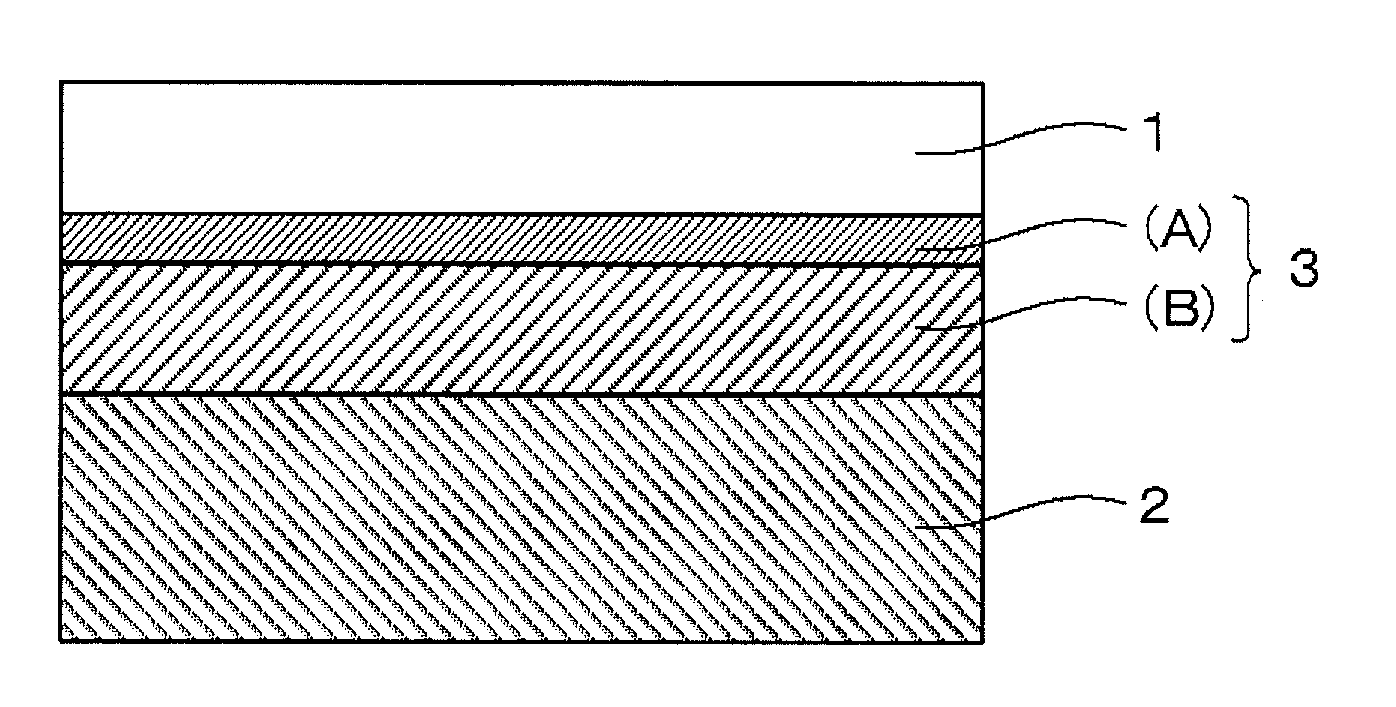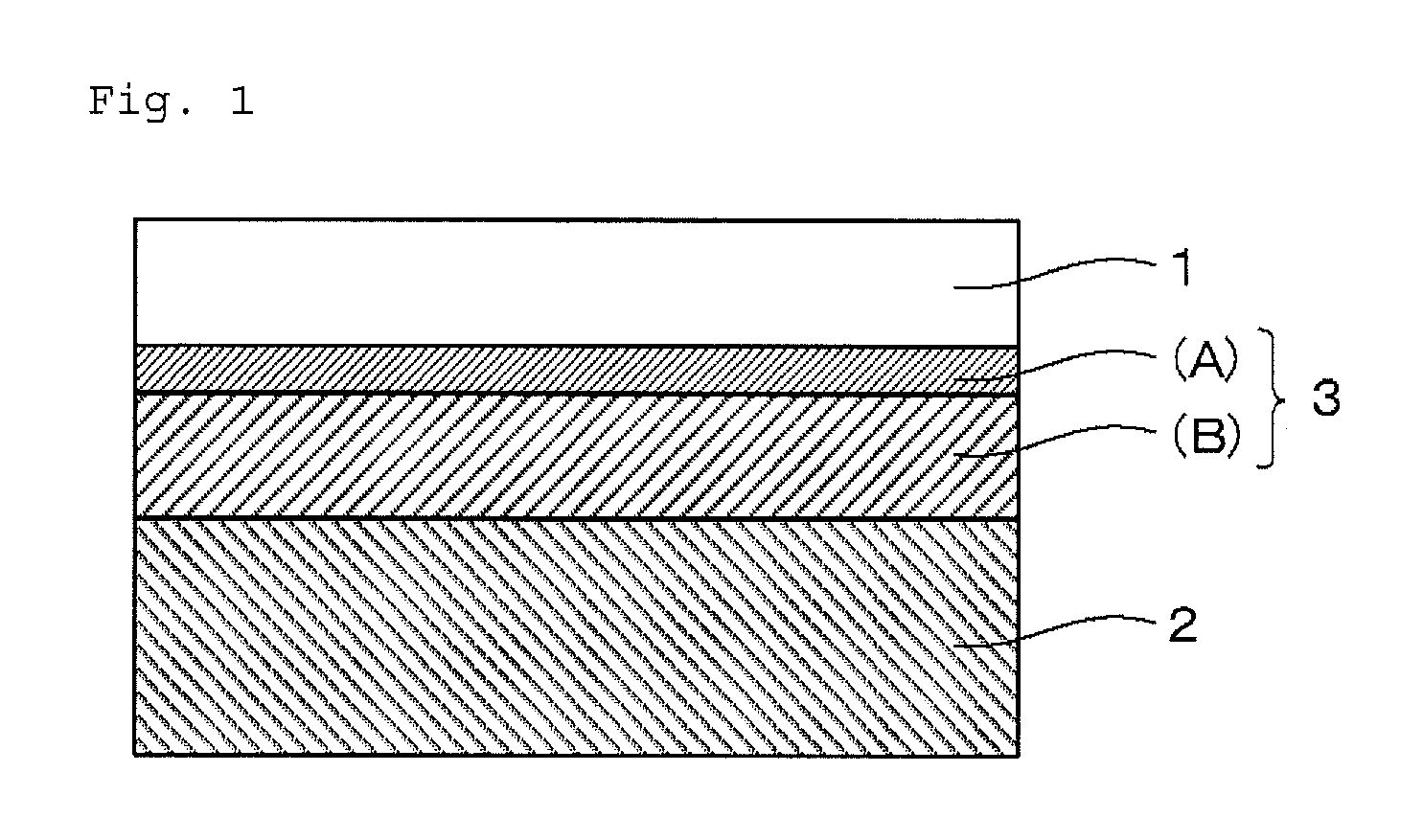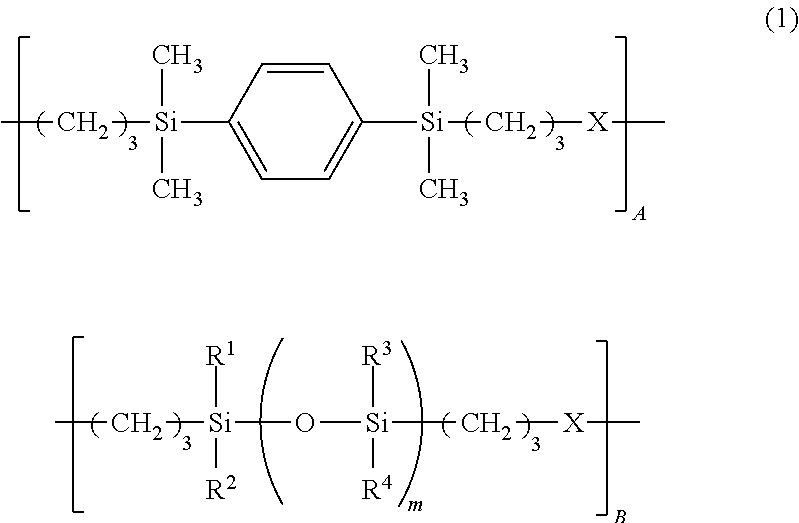Temporary adhesive material for wafer, film for temporary adhesion using same, wafer processing laminate, and method for producing thin wafer using same
- Summary
- Abstract
- Description
- Claims
- Application Information
AI Technical Summary
Benefits of technology
Problems solved by technology
Method used
Image
Examples
synthesis example 1
[0148]In a flask equipped with a stirrer, a thermometer, a nitrogen purge system, and a reflux condenser, 43.1 g of 9,9′-bis(3-allyl-4-hydroxyphenyl)fluorene (M-1), 29.5 g of organohydrogenpolysiloxane having an average structural formula (M-3), 135 g of toluene, and 0.04 g of chloroplatinic acid were placed, and heated at 80° C. 17.5 g of 1,4-bis(dimethylsilyl)benzene (M-5) was then added dropwise to the flask over 1 hour. At this time, the temperature in the flask was increased to 85° C. After the completion of dropwise addition, the mixture was aged at 80° C. for 2 hours, toluene was distilled off, and 80 g of cyclohexanone was added, to obtain a resin solution (A-1) containing cyclohexanone as a solvent, and having a resin solid concentration of 50% by mass. The molecular weight of the resin in the solution was determined by GPC, and the weight average molecular weight was 45,000 in terms of polystyrene.
synthesis example 2
[0149]In a 5-L flask equipped with a stirrer, a thermometer, a nitrogen purge system, and a reflux condenser, 396.9 g of compound (M-1) and 45.0 g of compound (M-2) were dissolved in 1,875 g of toluene. 949.6 g of compound (M-3) and 6.1 g of compound (M-4) were then added to the flask, and heated at 60° C. After then, 2.2 g of carbon-supported platinum catalyst (5% by mass) was added. It was confirmed that the internal reaction temperature was increased to 65 to 67° C. The temperature was then increased to 90° C. for 3 hours, and decreased to 60° C. 2.2 g of carbon-supported platinum catalyst (5% by mass) was added, and 107.3 g of compound (M-5) was added dropwise to the flask over 1 hour. The temperature in the flask was increased to 78° C. After the completion of dropwise addition, the mixture was aged at 90° C. for 3 hours, and cooled to room temperature. 1,700 g of methyl isobutyl ketone (MIBK) was added. The reaction solution was filtered under pressure through a filter to remo...
synthesis example 3
[0150]In a 5-L flask equipped with a stirrer, a thermometer, a nitrogen purge system, and a reflux condenser, 84.1 g of epoxy compound (M-2) was dissolved in 600 g of toluene. 294.6 g of compound (M-3) and 25.5 g of compound (M-4) were then added to the flask, and heated at 60° C. After then, 1 g of carbon-supported platinum catalyst (5% by mass) was added. It was confirmed that the internal reaction temperature was increased to 65 to 67° C. The temperature was then increased to 90° C., and the mixture was aged for 3 hours and cooled to room temperature. 600 g of methyl isobutyl ketone (MIBK) was added. The reaction solution was filtered under pressure through a filter to remove the platinum catalyst. The solvent in the resin solution was distilled under reduced pressure and 270 g of cyclopentanone was added to obtain a resin solution (A-3) containing cyclopentanone as a solvent, and having a solid content concentration of 60% by mass. The molecular weight of the resin in the resin ...
PUM
| Property | Measurement | Unit |
|---|---|---|
| Thickness | aaaaa | aaaaa |
| Thickness | aaaaa | aaaaa |
| Adhesion strength | aaaaa | aaaaa |
Abstract
Description
Claims
Application Information
 Login to View More
Login to View More - R&D
- Intellectual Property
- Life Sciences
- Materials
- Tech Scout
- Unparalleled Data Quality
- Higher Quality Content
- 60% Fewer Hallucinations
Browse by: Latest US Patents, China's latest patents, Technical Efficacy Thesaurus, Application Domain, Technology Topic, Popular Technical Reports.
© 2025 PatSnap. All rights reserved.Legal|Privacy policy|Modern Slavery Act Transparency Statement|Sitemap|About US| Contact US: help@patsnap.com



